China UHPC applications for infrastructure, building, power, rehabilitation, precast products, etc. kept growing in 2024. Some innovated UHPC or composite structures were realized on the actual projects. Herewith, some of these progress or achievements are presented.
Volume of UHPC Used in China
Based on the data collected via questionnaire forms received from 49 major UHPC related enterprises in China, total 200,436 m3 of UHPC were used for various projects and products in January ~ December, 2024, and about 241,922 metric tons of UHPC premix produced. During 2019 ~ 2024, annually used UHPC volume in China is shown in the chart below. The average or composite annual growth rate is 46%.
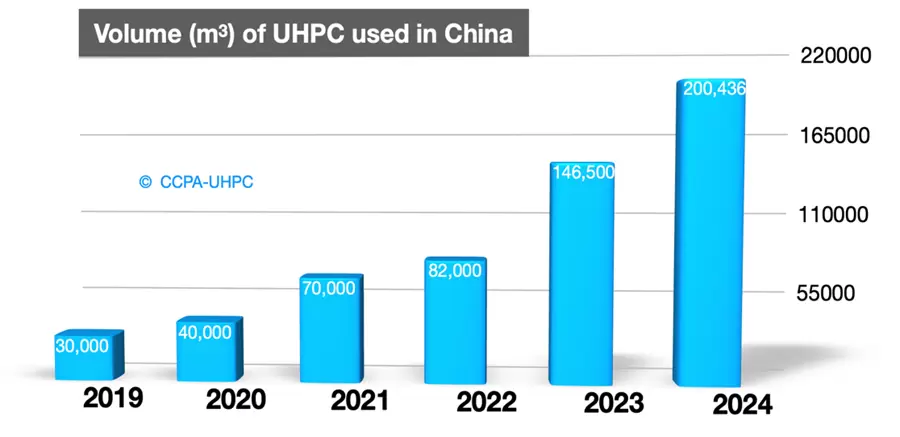
Volume Share of UHPC Applications
The volume share of UHPC used in 2024 is shown in the chart below. The volume of all applications grows up.

- 47% UHPC applied to bridges, in which
> 11% UHPC used for steel-UHPC composite decks, total completed deck area exceeds 377,312m2
> 10% used for structural connections of precast concrete elements (wet joints), and
> 26% used for prefabricated components (girders, deck slabs, etc.), major growth of total volume
- 20% UHPC applied to wind turbine towers
- 14% UHPC applied to municipal, power supply & hydraulic engineering
- 14% UHPC for buildings, in which
> 3% UHPC used for structural components (beam, column, staircase, etc.)
> 11% used for curtain wall and façade, total completed wall area exceeds 552,278m2
- 2% UHPC for strengthening and rehabilitation
- 4% UHPC for the others, mainly various UHPC products, such as durable gutter & cover, light or slender frame, pipe, etc.
Highlights for UHPC Bridges
Sustained application: steel-UHPC composite deck for bridges
The total deck area of steel-UHPC composite deck for new bridges and old bridge rehabilitation completed in 2024 keeps steady, comparing to the previous three years, as shown in the chart below.
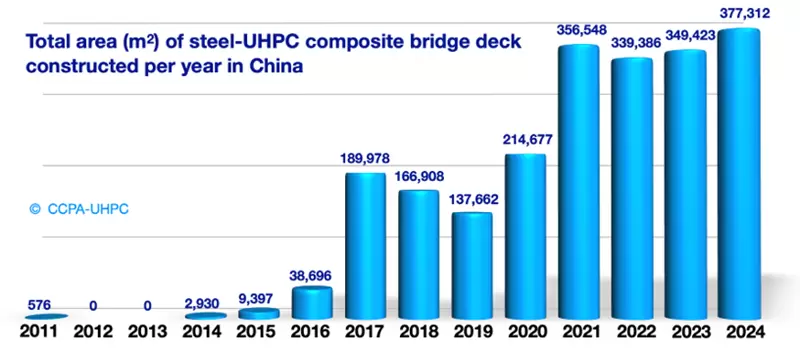
Tongling Yangtze River Highway & Railway Bridge (see pictures below) with deck area of 48,160m2 is one of 78 bridges using steel-UHPC composite deck in 2024.

Fast growing applications: precast UHPC structural components for bridges
Apart from steel-UHPC composite deck, the UHPC volume of precast structural components, such as slab for steel-UHPC girder and prestressed I-girder, etc. amounts to 52,847m3 in 2024, a 12-fold increase compared to 2023‘s volume.
One example is Zhijiang Bailizhou Yangtze River Bridge (see pictures below), a cable-stayed bridge with a main span of 890m. Its middle span and south span, total length of 1,265m, are built with steel-UHPC composite girder, which consists of prefabricated steel box and precast UHPC deck slab. The UHPC slab is precasted and steam cured at a factory.

Another example is the light UHPC I-girder bridge system, as shown in the pictures below. A series of 8m ~ 22m span of such UHPC girder highway bridge system are well developed and documented in Gansu Province. In 2024, 15 such UHPC girder bridges were constructed, fully showcase the advantages of this new generation of highway bridges, i.e. fast-construction and similar cost in comparison to traditional concrete bridge, furthermore, the long-term benefits of durability, low maintenance & less traffic disturb, etc. Therefore, these UHPC girder bridges would be very competitive, especially in harsh, aggressive environment.

Innovative structures (1): Weldless orthotropic composite bridge deck structure
A new type of weldless orthotropic composite bridge deck, developed by Prof. Xudong SHAO’s team of Hunan University, was industrially prefabricated, installed, connected for the box girder of a viaduct project in Changsha, Hunan Province. This new orthotropic composite bridge deck structure, as shown in graphs below, consists of shaped I-steel & channel steel, steel slat, R-UHPC slab, welding stud for steel-UHPC connection, as well as joint connection with UHPC on site, i.e. except for stud welding, there is no welding of steel plates in the new orthotropic deck. Traditional bridge orthotropic decks of steel plate welded structure are susceptible to damage and require frequent maintenance, since its welding seams are prone to cracking when subjected to fatigue stress. Without welding seam, the new orthotropic deck structure successfully solved the long- standing ‘fatigue problem’. Compared to traditional orthotropic deck, this new deck weighs similar but costs half, can adapt to the stress requirements of various complex structures such as large span cable-stayed and suspension bridges.


Innovative structures (2): Steel-concrete-UHPC composite bridge deck
A new steel-concrete-UHPC composite bridge deck system has developed by Shanghai Pudong Architectural Design and Research Institute (PDADRI) and verified theoretically and experimentally for flexural, shear, punching and fatigue resistance. In 2024, the girder, combining two narrow steel box with this steel-concrete-UHPC composite deck, has been firstly used for a new Shenjiang South Road cross-line bridge (span 40m+60m+40m continuous girder, width 16.5m, see graphs & pictures below). This practical project proved the design expectations: simplified construction process on site (faster installation and shorter traffic affecting, no formwork and easy concreting), reducing the steel usage and construction cost while the structural performance & durability improved, releasing more space for ground traffic, since this structure design allows longer span and extended cantilever deck, and the ground space is the most valuable resource in the densely populated city like Shanghai.
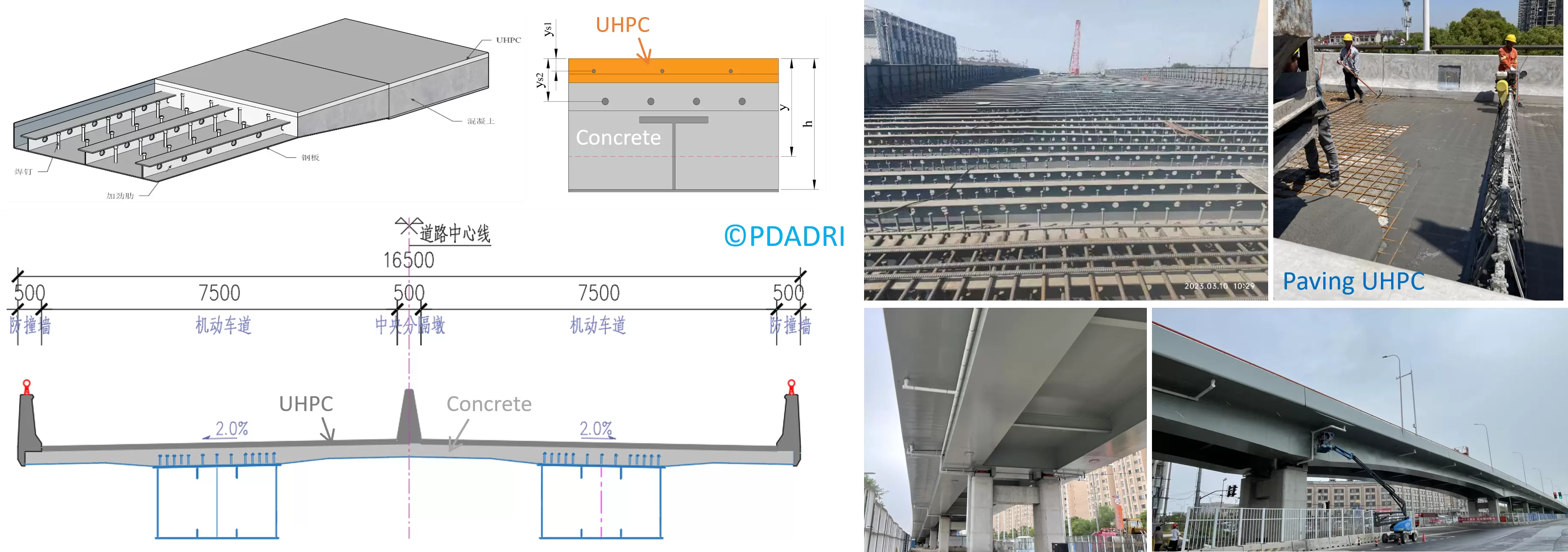
Highlights for Wind Turbine Towers
Since the first UHPC-steel hybrid wind turbine tower with height 180m (ground to turbine hub center) was erected in Oct. 2023, Shanghai FL Renewables has further designed UHPC-steel hybrid towers covering height from 120m to 180m, and constructed total 100 towers at the end of 2024. In Nov. 2024, a new height 185m (turbine hub center height) of UHPC-steel tower was created by Shanghai FL Renewables for the wind power project in Yilan County of Harbin (see pictures below). However, this height record was only kept for one month.

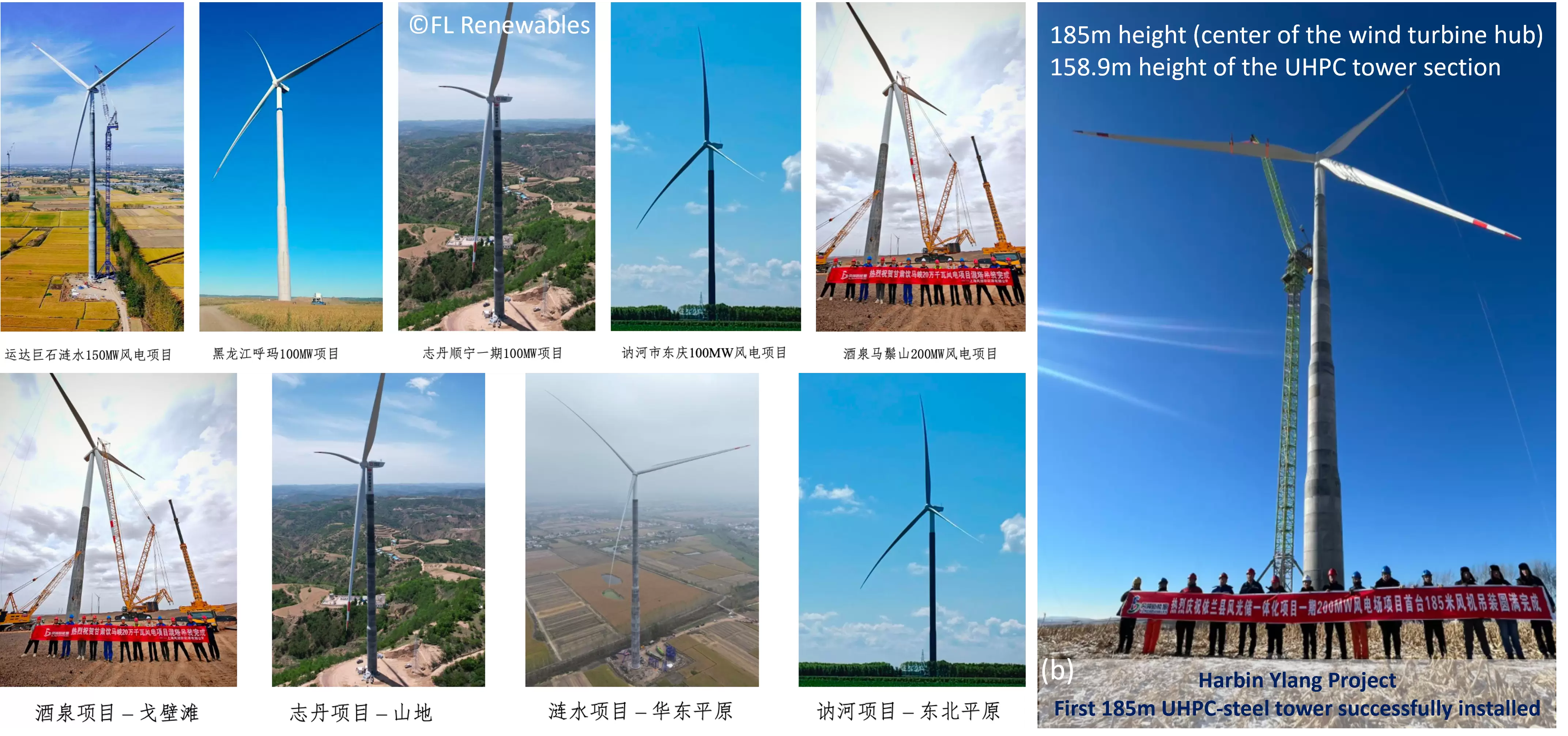
On Dec. 18, 2024, a UHPC-steel hybrid tower with 190m height (center of turbine hub) was erected jointly by Jianhua Building Materials and Envision Energy (see pictures below).
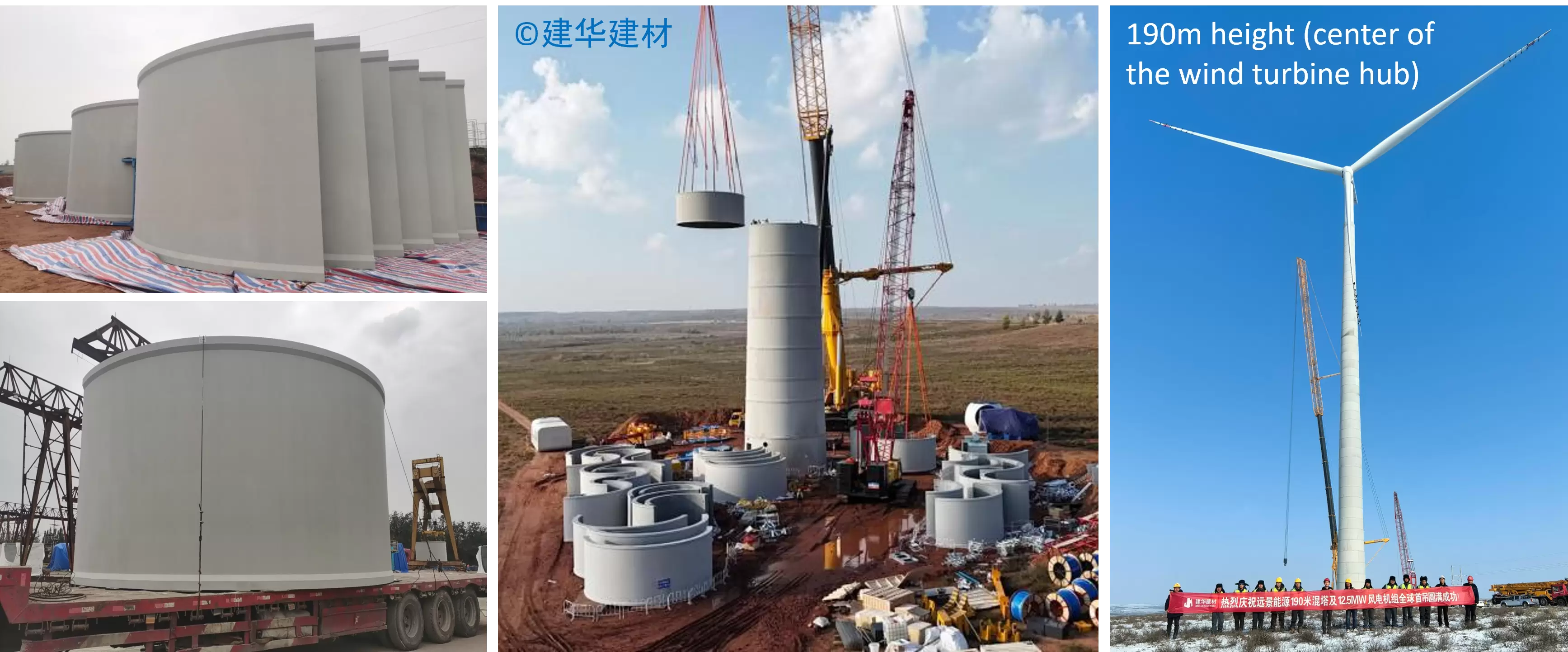
Highlights for Buildings
Large UHPC cantilever structure for giant helical stair
The outdoor giant helical stair of Shanghai Grand Opera House is designed to appear as an “unfolded Chinese fan” (see graph below, left). This is an imaginative and very attractive architecture design, but presents several structural challenges, since the maximum cantilever ("fan handle") of helical stair is 32m, while the structural height is limited to 725mm within outer 15.5m of the "fan handle", i.e. span-to-height ratio reaches 21, which is much larger than that of conventional cantilever beams (4~6). Based on careful analysis and experiments, a solution of prefabricated prestressed UHPC cantilever beam and cast-in-place UHPC tread plate to form the outer 15.5m cantilever helical stair was proposed, and successfully realized in 2024 as shown in below picture (right). This UHPC structure not only meets the requirements for strength, stiffness & comfort, structural integrity, fire resistance and durability, but also perfectly presents the architectural concept and aesthetic effect, as well as saves the cost and reduces carbon footprint. So, it’s an excellent showcase of UHPC structure for building.

Shanghai Grand Opera House project Architect [Snøhetta / ECADI,Structure: East China Architecture Design & Research Institute (ECADI),Contractor: Shanghai Construction No.4 (Group)]
Complex UHPC curtain wall for dome structure
Galaxy Macau Phase 4 project has an unique building – the central dome (clear height 13.45m, diameter 48m), consisting of a steel structure, UHPC curtain wall, vertical and skylight glass curtain wall. The UHPC curtain wall is composed of 9-storey hyperbolic cantilevered UHPC prefabricated components, which function both for decoration and load-bearing with the ability to resist typhoons. Furthermore, high impermeability, weather and fire resistance is specified for UHPC. Due to the large size, complex shape and structure of UHPC components, it is extremely difficult to prefabricate, transport and hoist components. With full cooperation of all participating parties and through continuous innovations, all the problems encountered in the prefabricated and installation process were successfully solved, and the unique dome building was satisfactorily constructed (see pictures below).

New connecting mode for UHPC assembly frame structure
Ningbo Electric Power Design Institute, China Academy of Building Research (CABR) and Zhejiang Hongri Tenacal have jointly developed a new connection mode of UHPC assembly frame structure. This mode combines UHPC components with steel structure connection methods, i.e. the steel connectors are embedded at the connecting nodes of precast UHPC beams and columns, then the structural connection of beams and columns on site is realized by connecting steel connectors without support, afterwards, the steel connecting nodes are covered with lightweight concrete for corrosion protection. This new prefabricated and connected frame structure system has been verified by theoretical analysis and full-scale tests for load bearing capacity, seismic performance and reliability, and successfully applied to the buildings of Banlu 110kV Power Transmission and Transformation Station in Zhenhai, Ningbo. The engineering practice has well proved that the "prefabricated UHPC components + steel connection nodes" could truly and fully assemble frame structures, i.e. no mold, no support and rapid assembly, efficient construction, see pictures below.
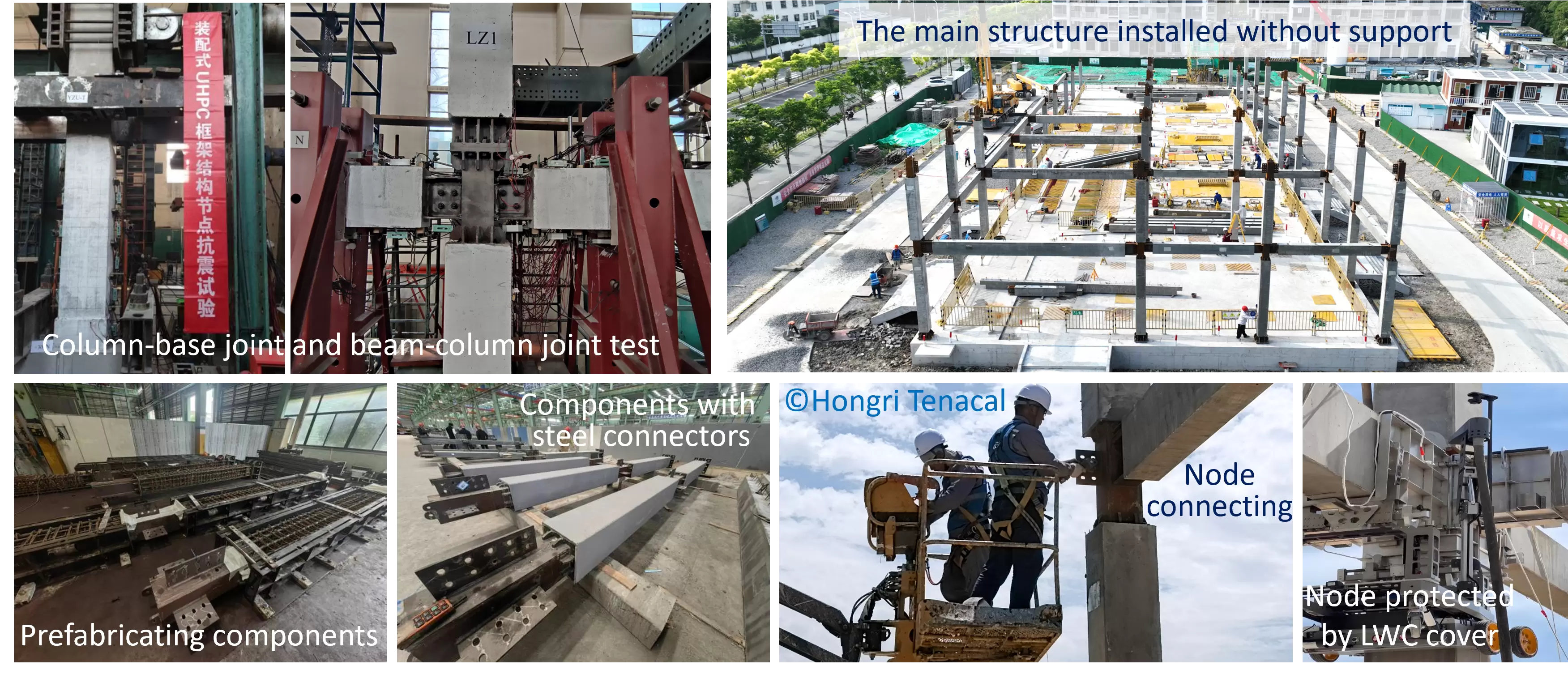
Creative Products of UHPC
UHPC energy storage cabinet
The conventional energy storage cabinet is composed of steel container shell, internal equipment and control system, etc., if the internal battery pack is thermally uncontrolled due to various reasons, the energy storage cabinet will quickly form high-temperature environment inside, and the steel structure shell will be deformed or lose its bearing capacity under the action of high temperature, resulting in secondary disasters such as fire and explosion. There have been many similar accidents worldwide in recent years. In response to this problem, Taiwan Cement Corporation (TCC) developed and cooperated with CSCEC No.1 Bureau and CSCEC Tianjin Industrial to produce UHPC energy storage cabinets, and conducted a series of tests, which proved that UHPC energy storage cabinet has good performance of fire and explosion prevention, can extinguish fire by water injection, thus can safely store electric energy and provide stable electricity services. In addition, it is durable, has lower carbon footprint. Due to these advantages, UHPC energy storage cabinets, as new generation of cabinets, hav been already put into use (see pictures below).

Durable and assembly UHPC highway guardrail
The cast-insitu concrete highway guardrail is very time consuming, and its durability is poor in the deicing salt attacked areas of northern and north-western China. In order to solve these problem, Shanxi Transportation Science and Technology R&D developed a new type of highway UHPC assembled guardrail, which is an integrated protective structure forming by prefabricated UHPC thin enclosure and on site filling ordinary concrete. This UHPC guardrail has passed the safety performance tests of high speed real vehicle collisions. In 2024, 52.5km guardrail has been constructed for a highway project, and the practice presented that the new guardrail can be quickly and conveniently installed, as expected. The UHPC durability tests is still ongoing, so far UHPC surface seems intact after exposed to 600 cycles of salt water freezing and thawing. Technically, the major difficulty of the UHPC guardrail is how to efficiently produce the complex thin-walled (thickness of 25 ~ 50mm) UHPC enclosures. Through continuous attempts, innovation and improvement, the R&D team has successfully established a modern production line equipped with rapid mold assembly and disassembly, automatic UHPC mixing and distribution, efficient product moving, steam curing, and intelligent production management & control system, etc., capable of annully producing 140,000 linear meter of UHPC enclosure (see pictures below).

Publication of UHPC books
The monograph written by Prof. Shao Xudong and his team “基于超高性能混凝土的桥梁新结构——理论、试验与应用 (Innovative Bridge Structures Based on Ultra-High Performance Concrete – Theory, Experiment and Application” (Chinese version) was published in Dec. 2022 by China Communications Press. The English version of this book was published in 2024 jointly by China Communications Press and Elsevier. For the English publication, Prof. Chen Zhengqing and Prof. Eugen Brühwiler wrote the forewords respectively, and they said:
“In this book, Innovative Bridge Structures Based on Ultra-High Performance Concrete (UHPC), a series of UHPC-based new bridge structures and their application examples in different types of bridge structures are described in detail, reflecting the full aspects of the innovative research outcomes, from new materials, to new structures, new theories, new methods, and new standards. The main contents include basic properties of UHPC and its applications in bridge engineering; design methods of UHPC-based bridges; steel-UHPC lightweight composite deck structures; UHPC strengthening for in-service cracked orthotropic steel decks; UHPC bridge deck structures; box girder bridges; prefabricated girder bridges; exploration of a new system of super-long-span arch bridges; UHPC for concrete bridge deck strengthening; fully prefabricated large cantilevered high-strength steel-UHPC composite bent caps; and UHPC joints.” By Prof. Chen Zhengqing of Hunan University
“This book compiles innovative and novel bridge designs and implies that bridge engineering must evolve. It is a must for modern bridge engineers, eager to know what comes next after traditional reinforced concrete and steel construction, and wanting to go beyond conventional designs. This book will hopefully become a reference and basis for the training of structural engineers and students. Also, the profession still needs to be “converted” to more sustainable structural and bridge engineering, and this book provides significant contributions. May this book become an essential reference in modern bridge construction. I wish this book many interested readers and lively discussions about the future of our bridge engineering. Welcome to the postconcrete era!” By Prof. Eugen Brühwiler of EPFL
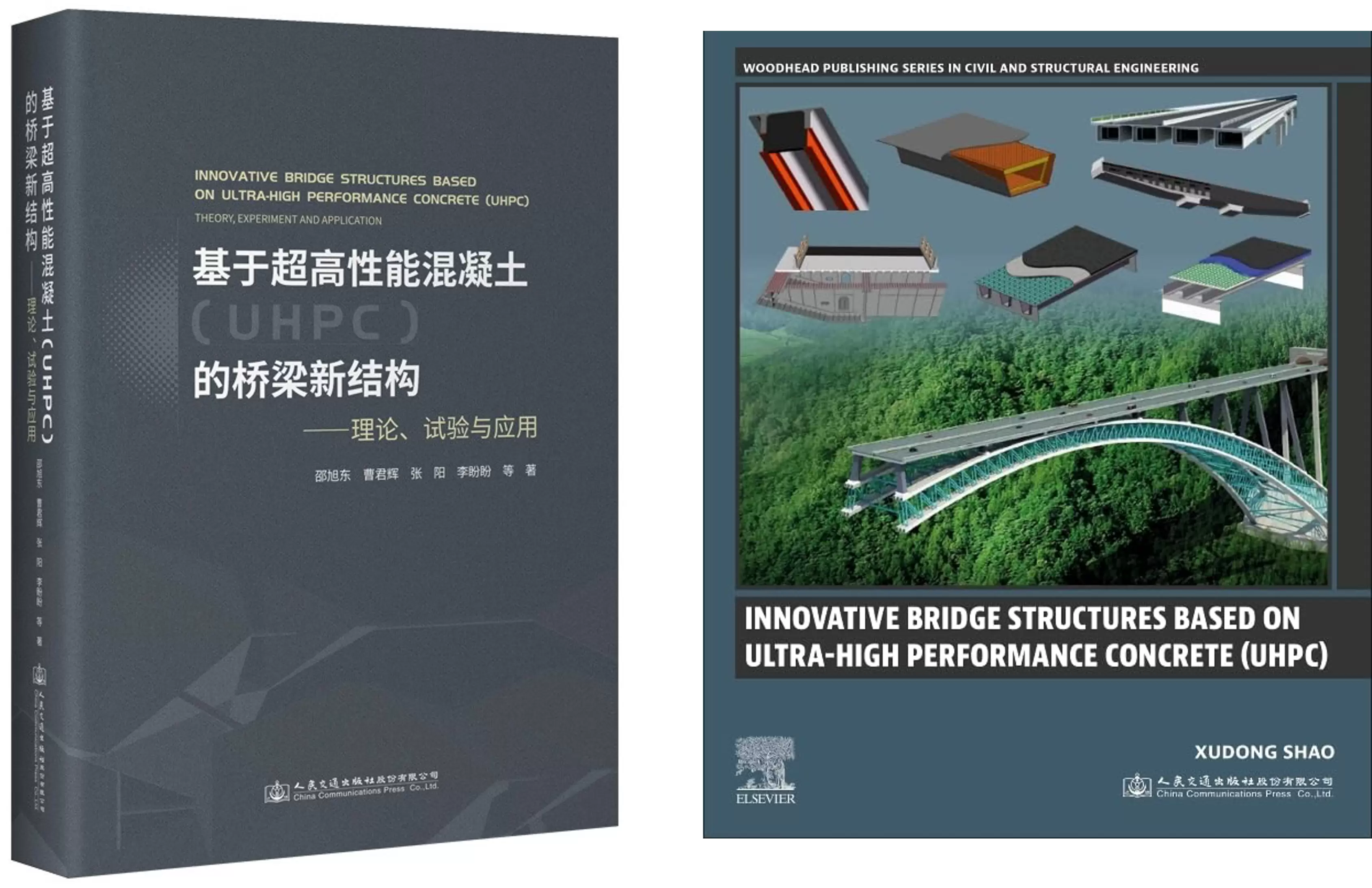
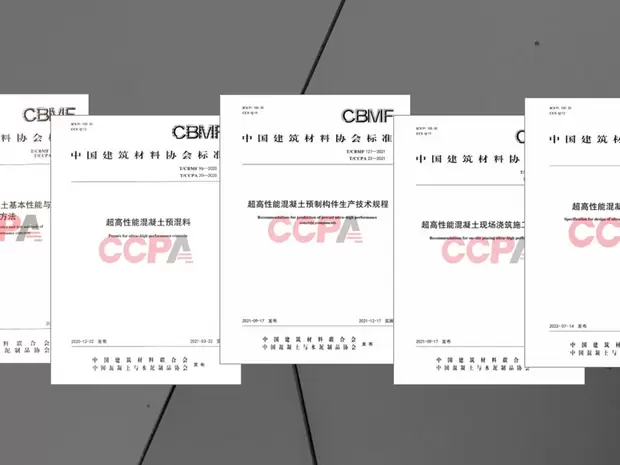
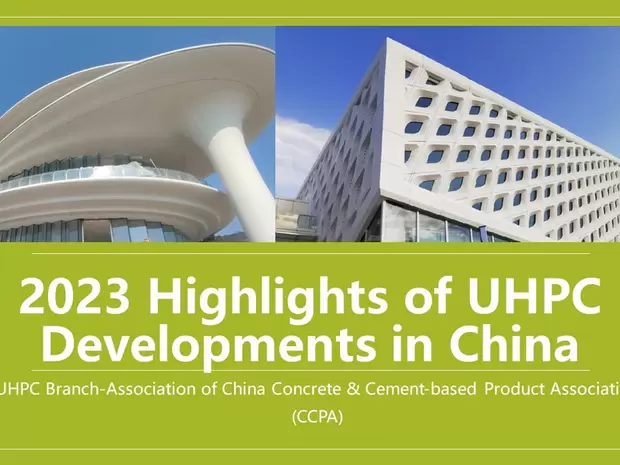
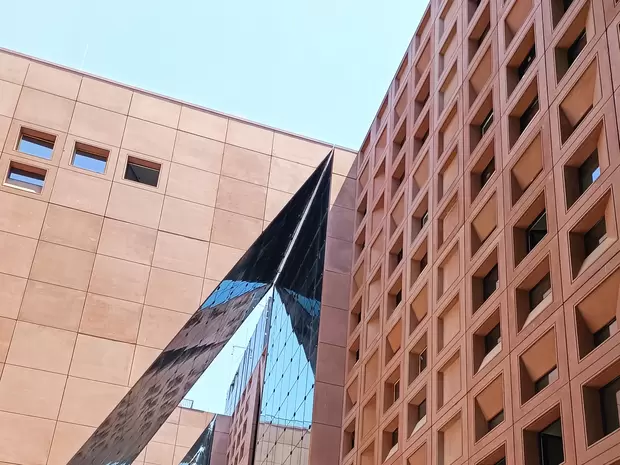

Share on